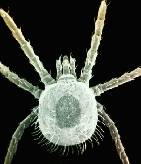 |
 |
 |

China Documents First Case of Tick-Borne Disease Spread
Human-to-human transfer caused by contact with blood, respiratory secretion|
|
HealthDay
By Robert Preidt
Tuesday, November 18, 2008
 TUESDAY, Nov. 18 (HealthDay News) -- The first Chinese case of a tick-borne disease called granulocytic anaplasmosis (HGA), which then led to person-to-person transmission of the disease, is described in a study by researchers at China's National Institute of Communicable Disease Control and Prevention.
TUESDAY, Nov. 18 (HealthDay News) -- The first Chinese case of a tick-borne disease called granulocytic anaplasmosis (HGA), which then led to person-to-person transmission of the disease, is described in a study by researchers at China's National Institute of Communicable Disease Control and Prevention.
It's the first known report of human-to-human transmission of HGA.
HGA was identified in the United States in 1990 and in Europe in 1997. The number of infections reported each year in the United States is rising, with infection rates in endemic areas as high as 15 percent to 36 percent.
The Chinese team launched an investigation after a cluster of HGA cases occurred in health-care workers and family members following exposure to a patient with disease symptoms consistent with HGA. The female patient was bitten by a tick 12 days before the onset of fever and hemorrhage. She was admitted to a regional hospital in Anhui province, and later died. Of 28 people who had close contact (20 inches or less) with the patient during the final 12 hours of her life, nine became infected with the type of bacteria (A. phagocytophilium) that causes HGA. All nine reported contact with the patient's blood, and seven had contact with her respiratory secretions.
"The most remarkable aspect of these cases was that transmission was very unlikely to be tick-borne, but was closely associated with blood or respiratory secretion from hemorrhage," the researchers wrote. "Although it is likely that routine blood and fluid precautions will protect against such future events, strict adherence to protective protocols is mandatory even if communicability is deemed unlikely."
The researchers added that the lessons of this case study "remain relevant to the daily hospital and health care unit operations to prevent any additional [hospital] outbreaks of HGA. Moreover, as China advances into the future, it must also now become prepared to deal with the increasing threat that tick-borne rickettsial pathogens (parasitic bacteria that live in ticks and mites and can cause disease in humans) have already been brought to the United States and Europe."
The study was published in the Nov. 19 issue of the Journal of the American Medical Association.
"This report certainly serves to reinforce the importance of adopting standard blood and body fluid precautions for all patients and especially for those with HGA; these precautions are the accepted standard of care in the United States," Dr. Peter J. Krause, of the Yale School of Medicine, and Dr. Gary P. Wormser, of the New York Medical College, wrote in an accompanying editorial. "The report also should stimulate further investigation of the existence of A. phagocytophilium in the region of China where this outbreak originated."
HealthDay
Copyright (c) 2008 ScoutNews, LLC. All rights reserved.
Related News:
More News on this Date
Related MedlinePlus Pages:
| Home | Health Topics | Drugs & Supplements | Encyclopedia | Dictionary | News | Directories | Other Resources | |
| Disclaimers | Copyright | Privacy | Accessibility | Quality Guidelines U.S. National Library of Medicine, 8600 Rockville Pike, Bethesda, MD 20894 National Institutes of Health | Department of Health & Human Services |
Date last updated: 19 November 2008 |




